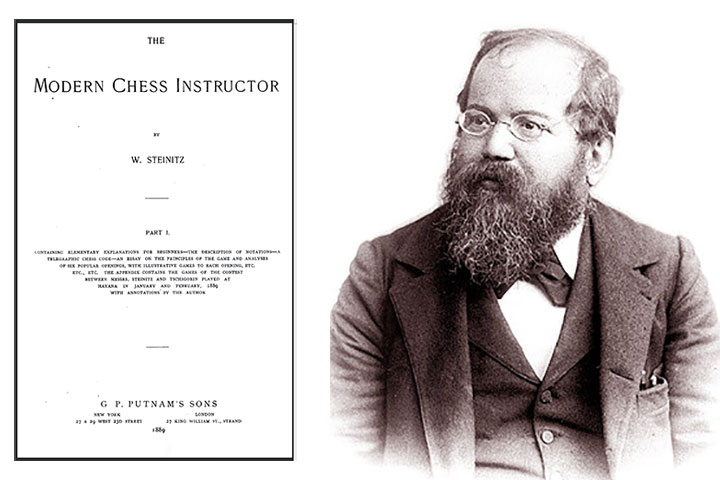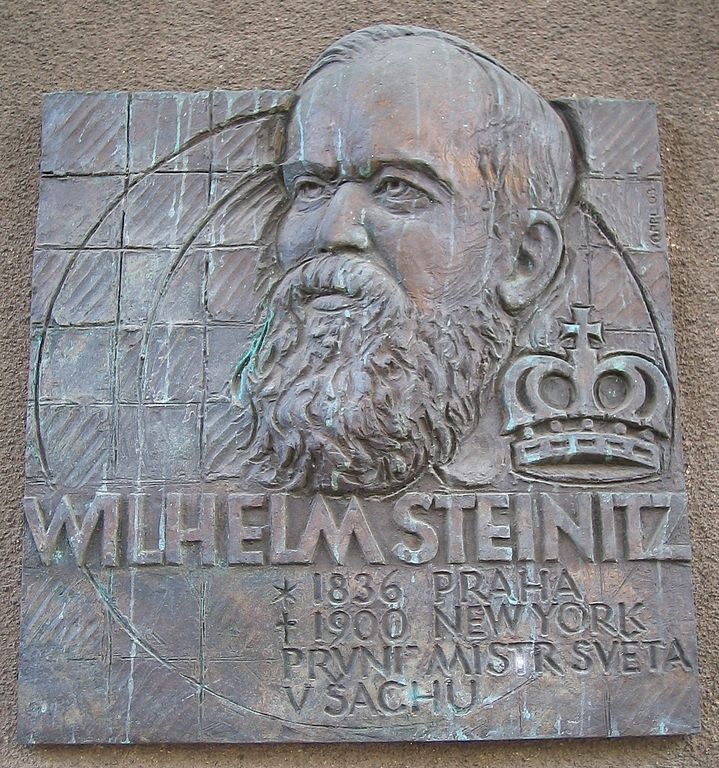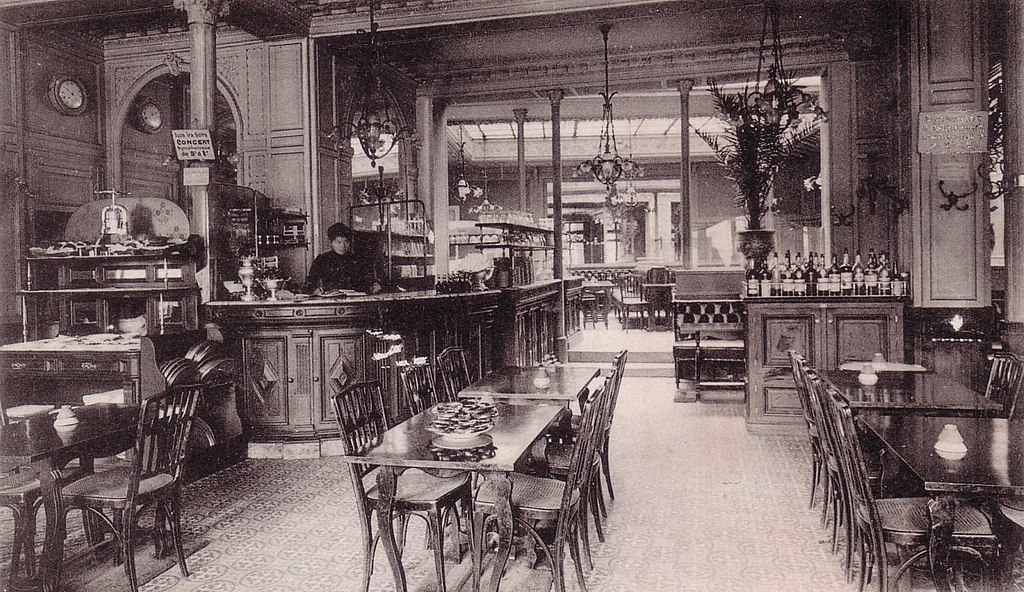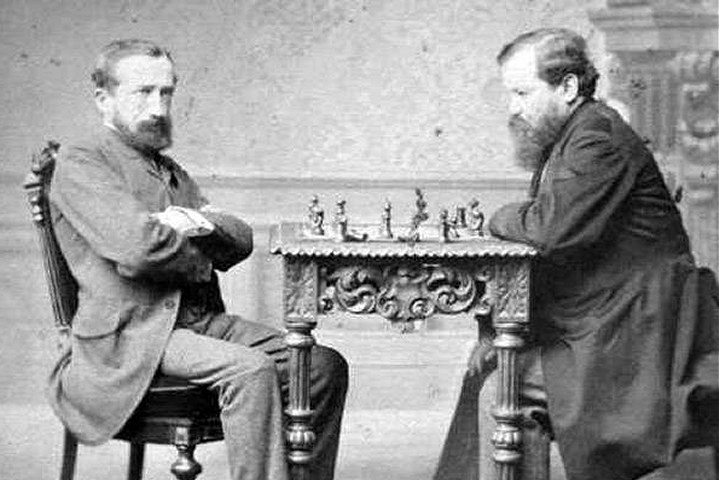


 Wilhelm Steinitz looms as one of the largest figures in chess. Earning the distinction of being the first ever World Champion in 1886, he was a successful competitive player and chess journalist whose theoretical teachings revolutionized chess and laid the foundations of the modern game. He is, arguably, chess’ greatest thinker.
Wilhelm Steinitz looms as one of the largest figures in chess. Earning the distinction of being the first ever World Champion in 1886, he was a successful competitive player and chess journalist whose theoretical teachings revolutionized chess and laid the foundations of the modern game. He is, arguably, chess’ greatest thinker.
Steinitz was born on May 14, 1836, in Prague, the capital of the Kingdom of Bohemia that is now the Czech Republic. He was the last of thirteen children of a poor Jewish tailor who groomed him to become a rabbi.
Steinitz and his family were confined in the Jewish ghettos of Prague, but when these were abolished in 1850, he became free to roam the city. One of his favorite places was the Café Wein, the chess haunt of the best players in Prague.
The young Steinitz was so proficient at mathematics that his parents soon abandoned their plans for a religious vocation for him and sent him instead to the Vienna Polytechnicum in 1857. He worked as a journalist in the city to support himself, but, with his income proving insufficient, he eventually abandoned his studies and turned to chess for a living.
Steinitz was already a strong player when he came to Vienna. He spent most of his time at the Café Rebhuhn, and there gradually developed into Vienna’s strongest player. He won the city’s championship on his third try in 1861, scoring 30 points out of 34 games. This performance was reminiscent of Paul Morphy’s dominance only three years before, that he became known as “The Austrian Morphy.”
Following his victory in 1861, the Vienna Chess Society asked Steinitz to represent Austria in the great London Tournament of 1862. This was to be his first international tournament, and the tough field that included Adolf Anderssen, Louie Paulsen and Johan Lowenthal would test him thoroughly. He finished only sixth, but won the tournament’s brilliancy prize for his game against Augustus Mongredien.
Steinitz must have found ample opportunities in London for a budding chess professional like him, because he attempted to stay there for good. For one, there was the legendary Simpson’s Divan, the only café in Europe that rivaled France’s Café de la Régence. There, Steinitz could give odds and make easy pickings of amateurs, or challenge other strong players to a match. It was in these matches, especially, that masters like Steinitz displayed their skills and built their reputation. With the players and their patrons placing huge bets aside, these matches became the gladiatorial, nerve-wracking contests of Victorian London.

The interior of the Café de la Régence circa 1906
Steinitz beat Joseph Henry Blackburne in 1863 (8-2), and Henry Bird in 1866 (7-5) in this sort of high-stakes play. Now considered as London’s strongest player, Steinitz challenged Adolf Anderssen shortly after beating Bird.
Anderssen had been considered the world’s best player after Paul Morphy withdrew from competition in 1858, and this he affirmed by winning London 1862. If Steinitz hadn’t surpassed him yet, he muddled the chess hierarchy, beating Anderssen narrowly, 8-6. Every game in this tough match was decisive, and Steinitz would always point to 1866 as the year he became world champion.

Find more info at Chess Archaeology
Yet, even Steinitz himself knew that his claims to ascendancy over Anderssen were shaky at best. Their match was tied at 6-6, and he might have only been fortunate to win the last two games. In the succeeding years, he failed to show clear superiority over his rival. Anderssen, in fact, won the great Baden-Baden Tournament of 1870, beating Steinitz in their two encounters.
The defeat so affected Steinitz that he began a thorough assessment of his game. While, perhaps, he only meant to fix his weaknesses, he could not have been aware that he had begun his theoretical undertakings that were to influence the game profoundly.
Three years later, in the strong Vienna Tournament of 1873, Steinitz unveiled a new, positional playing style. He won the tournament ahead of Anderssen, one of the few times he outperformed Anderssen in a non-match play.
Steinitz took a nine-year break from competition after this victory, and spent the period on that other significant endeavor of his career - chess journalism. In 1873, he became the chess correspondent of The Field, the leading British sports magazine.
The Field became Steinitz’s platform for his new approach to the game, and his writings and ideas were later to become the basis of the classical principles of chess. While these ideas were yet too novel for the Romantics to understand in Vienna 1873, they would soon awaken every player to a whole new understanding of the game.
When Steinitz returned to competition, he won the Vienna International Tournament of 1882. His great rival Anderssen had passed away, but a new force in his protégé had emerged. He was Johannes Hermann Zukertort. Like Steinitz, he had also beaten Anderssen and Blackburne in matches.
Zukertort won the equally strong London International Tournament of 1883 in dominant fashion, which established him and Steinitz as the two strongest players in the world. Only a match between them could settle the matter of the world’s best player.
The match came to be arranged almost three years later, in the United States of America in January 1886. It was, of course, no different from all the other tough matches they had been involved in as leading masters, what with the $2000 a side that Steinitz, Zukertort and their patrons had wagered. This time, however, the chess world wanted formality, and thus the players, their patrons, and the public alike acknowledged the match to be the first-ever World Chess Championship.

Johannes Zukertort and Wilhelm Steinitz
Zukertort raced to a 4-1 lead. Steinitz, however, fought back and proved too formidable for Zukertort, eventually wining, 10-5, to become the first official world champion. The match made it clear that Zukertort had not reached Steinitz’s level of positional understanding.

Find more info at Chess Archaeology
Steinitz defended his title successfully three times, twice against Mikhail Chigorin in 1889 and 1892, and against Isidor Gunsberg in 1890. He finally lost it to Emanuel Lasker in 1894, but by then he was already fifty-eight and well past his prime.
Steinitz remained competitive after losing the title, and finished respectably in great tournaments such as Hastings 1895, St. Petersburg 1895, Nuremberg 1896, and Vienna and Cologne in 1898. Only in London 1899 did he fail to land a prize, but then his health had already seriously deteriorated. He passed away the following year.
Steinitz stands as the most influential figure in the game, and no one has caused as much upheaval in chess thought as he did. He was a child of the Romantic Era, but was the first to sense the fundamental flaws of the “attack at all costs” Romantic style of play. His keenness and compelling
drive to search for the truths of chess gave rise to the Classical school. He demonstrated clearly the ideas and principles of this school in his writings, and they were completely understood and assimilated by the succeeding generations. Chess would move on to the Classical Era, its golden age, and the classical style of play would soon be perfected by outstanding players such as Siegbert Tarrasch, Akiba Rubinstein, and Jose Raul Capablanca.
Steinitz himself understood all his contributions when he said:
I was champion of the world for twenty-eight years (referring to 1866 as the year he became world champion) because I was twenty years ahead of my time. I played on certain principles, which neither Zukertort nor anyone else of his time understood. The players of today, such as Lasker, Tarrasch, Pillsbury, Schlechter and others, have adopted my principles, and, as is only natural, they have improved upon what I began, and that is the whole secret of the matter.
Steinitz true legacy has perhaps been aptly expressed by an adoring follower. “This little man,” he said, “taught us all to play chess.”
The following games of Steinitz are worthy of close study:
You can go over all five games in the replayer below. Feel free to try your own variations!
| Advertising |